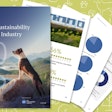
There are many ways that sustainability can be a business case, not just the right thing to do. - Stephie Volo, chief impact officer, Earth Animal
Ecology and economy often seem opposed to each other. Saving money and saving wildlife don’t always seem to go together. Nevertheless, sustainability efforts can benefit pet food companies' bottom lines while helping to create a better future. Industry experts discussed how sustainability can prove profitable during the Ask the Pet Food Pro panel discussion: Making Sustainable Pet Food at Petfood Forum 2024 in Kansas City, Missouri. Jim Lamancusa, executive director of the Pet Sustainability Coalition, hosted the discussion.
Question: Are there sustainability initiatives that save companies money?
Brian Steinwagner, executive vice president with sustainability responsibilities, Morris Packaging
Two big ones for us. One is right-sizing. There are so many packages that are oversized. Also, by going from a rigid container, a jug, into a flexible package, you've dramatically reduced your carbon footprint and saved money. Jugs are not cheap, right? [Second,] taking advantage of the new technologies in resin available out there, we can produce a bag that uses less overall total mil thickness but provides a stronger package than what you were getting three or four years ago.
Adam Craig, director of product development, Hill’s Pet Nutrition
The most obvious one that comes to my mind would be more on the manufacturing side and some of the efficiencies there, especially around energy usage. To build on your question, some of these areas we're exploring may have some upfront investment…As a specific example, let's use agriculture. To get farmers to transition to regenerative ag or alternative farming practices that can lower carbon footprints, we have to understand that's risky for them. We have to understand that their livelihood is on the line. How do we help get them over that threshold? That's where, upfront, there may be some investment at the supplier level. That then also needs to be managed at the manufacturer level, maybe even the pet parent level. Many of these practices may have some upfront investment, but in the long term, they will be neutral or maybe even a cost-benefit positive. We'll see how that goes. There will be this transition period, especially in the short term, when we may have to shoulder some additional costs to help with this transition. As that gains steam, things should be more manageable from a cost point of view.
Elizabeth Maier, director, growth and innovation, Wilbur-Ellis Nutrition
We're a very large company, so some low-hanging fruit in that area is something like transportation, recognizing where all the locations are, and trying to group shipments together because that saves in a bigger way when you're very large. Another one would be packaging and being very intentional about what you order. It can be hard to make changes in a large organization, but if you get a task force together or a group of people who actually care about the topic of sustainability, you'll be very surprised how quickly a couple of topics rise to the surface. You put people on them and a change can be made pretty fast. This is beyond product development; these are operational things that, if you put some thought and some people into it, you're actually going to make an impact.
Stephie Volo, chief impact officer, Earth Animal
We've been measuring our scope one and two greenhouse gas emissions for the past couple of years. After last year, we invested in an energy audit in our office space and in our retail store. That was free. I would encourage you all to contact your legislature and find out what different state bills and grants are available. We invested in many changes that took place at the beginning of the year. We have already seen savings. Additionally, we just transitioned to between 30 and 40% renewable energy. We've seen savings in our energy costs. We worked with our Master Herbalist to get her facility certified organic. We've seen a business case study in this. Our remedies are selling the best that they've ever sold. There are many ways that sustainability can be a business case, not just the right thing to do.


















